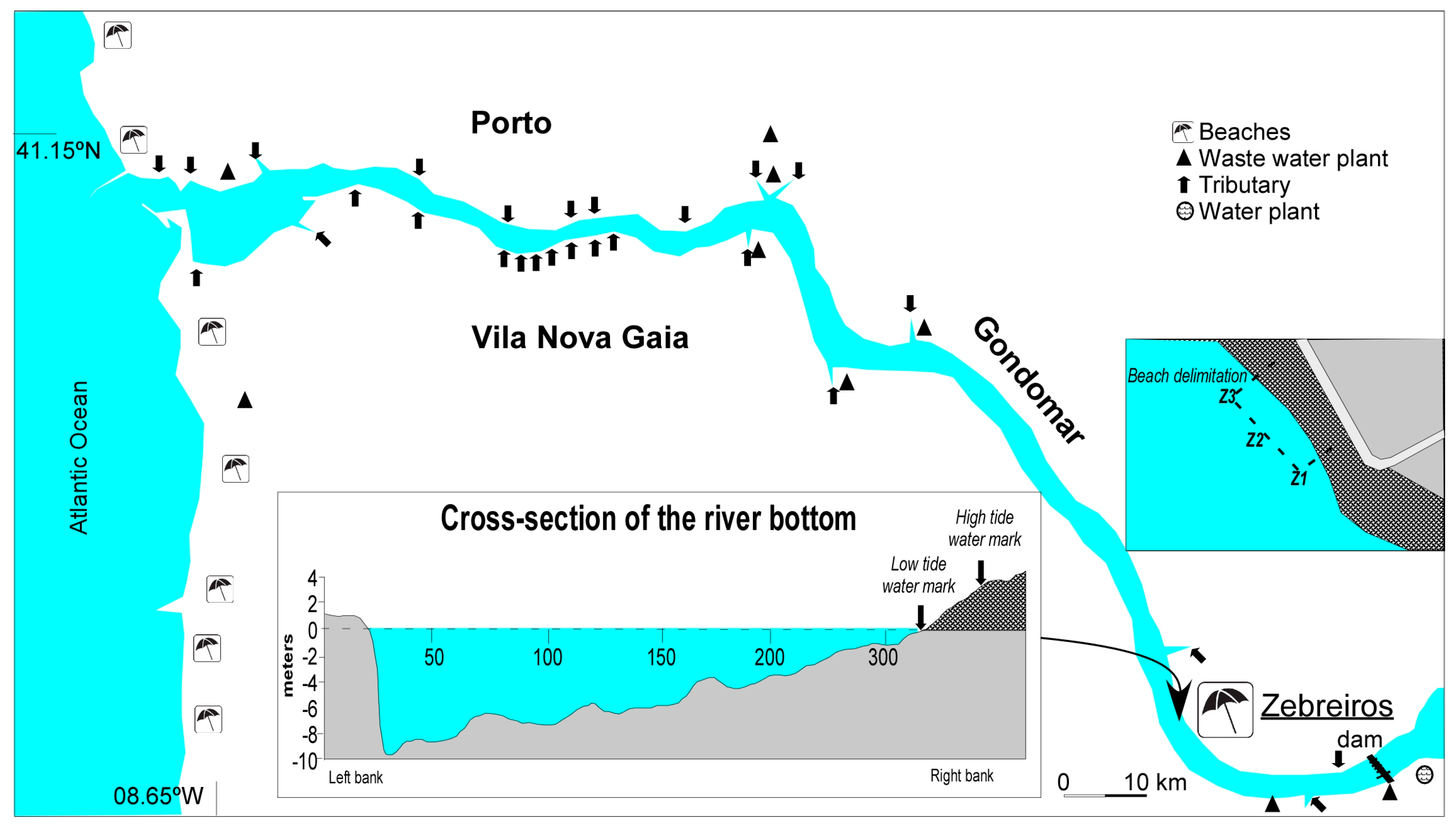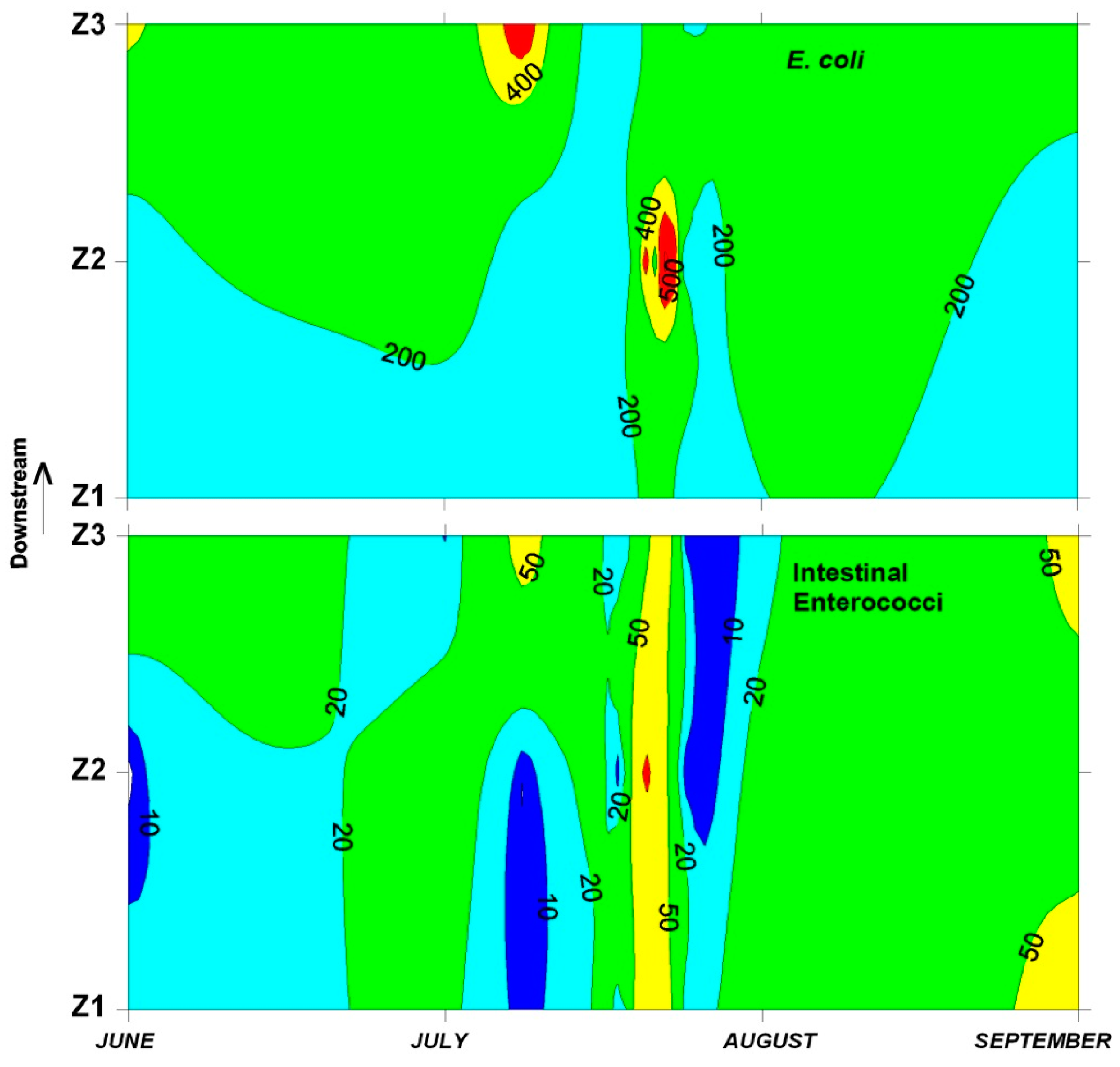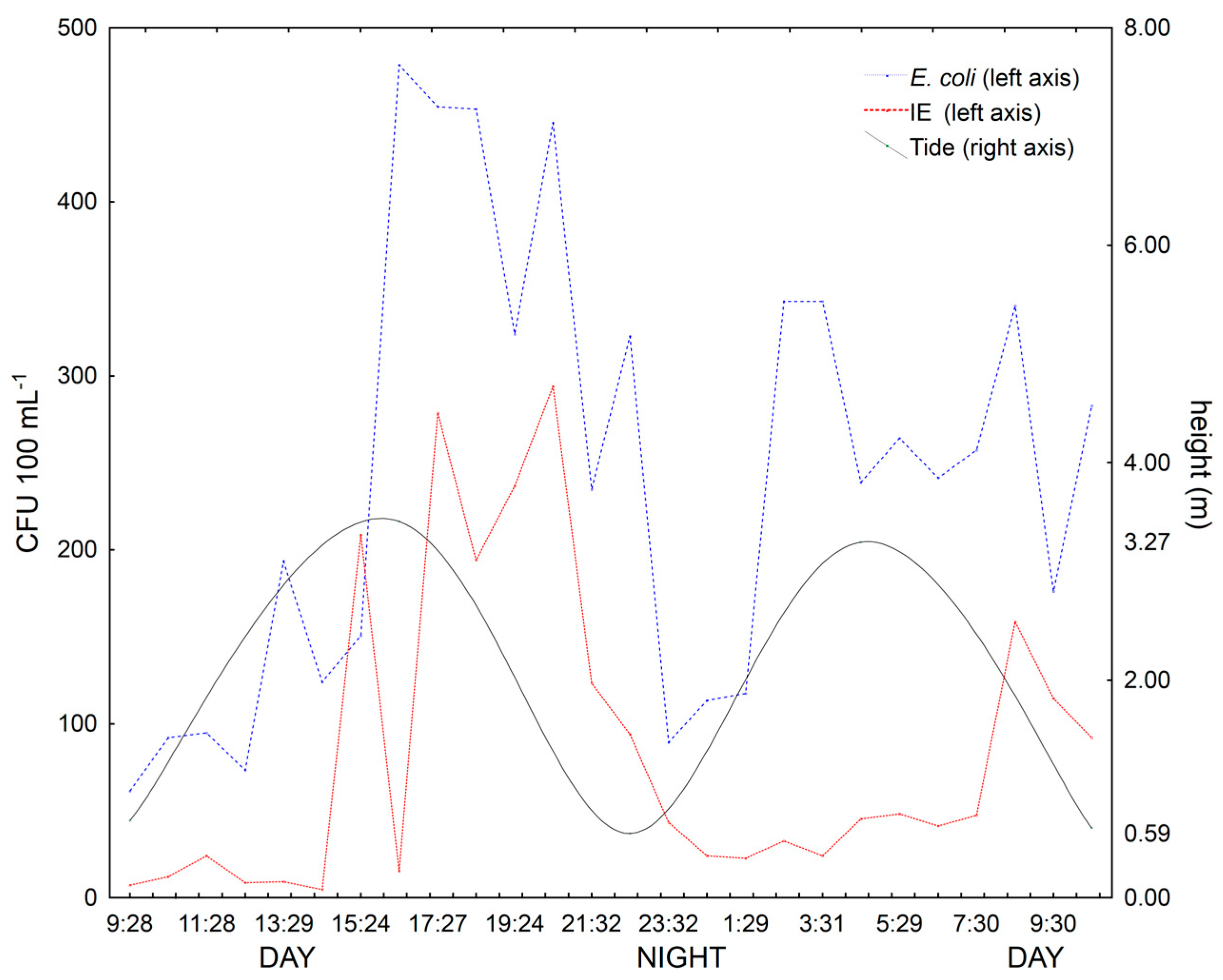Urban Estuarine Beaches and Urban Water Cycle Seepage: The Influence of Temporal Scales
Abstract
:1. Introduction
2. Materials and Methods
2.1. Area Description
2.2. Study Design
2.3. Analytical Procedures
2.4. Data Treatment
3. Results
3.1. Beach and Bathing Water Abiotic Characterization
3.2. Water Quality Indicators
3.3. Beach Use
4. Discussion
4.1. Bathing Water Quality
4.2. Perceived Quality
4.3. The Importance of Recreational Waters
5. Conclusions
- In the Douro estuary, water quality varies on an hourly scale, depending on the tide, rather than on a daily, weekly, or monthly scale during the bathing season.
- Intestinal enterococci seem to be a better indicator of estuarine water quality than E. coli, particularly during short-term events (hour-to-hour scale).
- The water quality tended to worsen during high tide due to the tidal excursion of more contaminated surface water from downstream highly urbanized areas, where sewage is inadequately treated and dozens of small contaminated urban tributaries discharge their flows.
- The present EU sampling strategy seems inadequate for tidal environments.
Acknowledgments
Author Contributions
Conflicts of Interest
References
- Mason, P. Tourism Impacts, Planning and Management, 3rd ed.; Routledge: New York, NY, USA, 2016; ISBN 978-1-315-78106-8. [Google Scholar]
- Rabinovici, S.J.M.; Berknopf, R.L.; Whitman, R.L. Economic and health risk trade-offs of swim closures at a Lake Michigan beach. Environ. Sci. Technol. 2004, 38, 2737–2745. [Google Scholar] [CrossRef] [PubMed]
- Costanza, R.; d’Arge, R.; de Groot, R.; Farberk, S.; Grasso, M.; Hannon, B.; Limburg, K.; d Naeem, S.; O’Neill, R.; Paruelo, J.; et al. The value of the world’s ecosystem services and natural capital. Nature 1997, 387, 253–260. [Google Scholar] [CrossRef]
- Pinto, R.; Marques, J.C. Ecosystem services in estuarine systems: Implications for management. In Ecosystem Services and River Basin Ecohydrology; Chicharo, L., Müller, F., Fohrer, N., Eds.; Springer: Dordrecht, The Netherlands, 2015; pp. 319–341. ISBN 978-94-017-9845-7. [Google Scholar]
- TEPatCotE, Union. Directive 2006/7/EC of the European Parliament and of the Council of 15 February 2006 concerning the management of bathing water quality and repealing Directive 76/160/EEC. Off. J. Eur. Union 2006, L64, 37–51. [Google Scholar]
- Wade, T.J.; Pai, N.; Eisenberg, J.N.; Colford, J.M., Jr. Do U.S. Environmental Protection Agency water quality guidelines for recreational waters prevent gastrointestinal illness? A systematic review and meta-analysis. Environ. Health Perspect. 2003, 111, 1102–1109. [Google Scholar] [CrossRef] [PubMed]
- Environmental Protection Agency (EPA). Bacteriological Ambient Water Quality Criteria for Marine and Freshwater Recreational Waters; PB86-158-045; US EPA: Springfield, VA, USA, 1986.
- Fewtrell, L.; Kay, D. Recreational Water and Infection: A Review of Recent Findings. Curr. Environ. Health Rep. 2015, 2, 85–94. [Google Scholar] [CrossRef] [PubMed]
- Boehm, A.B.; Grant, S.B.; Kim, J.H.; Mowbray, S.L.; McGee, C.D.; Clark, C.D.; Foley, D.M.; Wellman, D.E. Decadal and Shorter Period Variability of Surf Zone Water Quality at Huntington Beach, California. Environ. Sci. Technol. 2002, 36, 3885–3892. [Google Scholar] [CrossRef] [PubMed]
- Bordalo, A.A. Microbiological water quality in urban coastal beaches: The influence of water dynamics and optimization of the sampling strategy. Water Res. 2003, 37, 3233–3241. [Google Scholar] [CrossRef]
- Smith, S.D.A.; Markic, A. Estimates of Marine Debris Accumulation on Beaches Are Strongly Affected by the Temporal Scale of Sampling. PLoS ONE 2013, 8, e83694. [Google Scholar] [CrossRef] [PubMed]
- Colford, J.M., Jr.; Schiff, K.C.; Griffith, J.F.; Yau, V.; Arnold, B.F.; Wright, C.C.; Gruber, J.S.; Wade, T.J.; Burns, S.; Hayes, J.; et al. Using rapid indicators for Enterococcus to assess the risk of illness after exposure to urban runoff contaminated marine water. Water Res. 2012, 46, 2176–2186. [Google Scholar] [CrossRef] [PubMed]
- Rathnayaka, K.; Malano, H.; Arora, M. Assessment of Sustainability of Urban Water Supply and Demand Management Options: A Comprehensive Approach. Water 2016, 8, 595. [Google Scholar] [CrossRef]
- Amorim, E.; Ramos, S.; Bordalo, A.A. Relevance of temporal and spatial variability for monitoring the microbiological water quality in an urban bathing area. Ocean Coast. Manag. 2014, 91, 41–49. [Google Scholar] [CrossRef]
- FEE—Foundation for Environmental Education. Blue Flag Beach Criteria and Explanatory Notes 2017. Available online: https://static1.squarespace.com/static/55371ebde4b0e49a1e2ee9f6/t/5899e01ac534a5036aecbeeb/1486479387823/Beach+Criteria+and+Explanatory+Notes.pdf (accessed on 2 October 2017).
- Emery, K.O. A simple method of measuring beach profiles. Limnol. Oceanogr. 1961, 6, 90–93. [Google Scholar] [CrossRef]
- Araújo, S.; Henriques, I.S.; Leandro, S.M.; Alves, A.; Pereira, A.; Correia, A. Gulls identified as major source of fecal pollution in coastal waters: A microbial source tracking study. Sci. Total Environ. 2014, 470–471, 84–91. [Google Scholar] [CrossRef] [PubMed]
- Converse, R.R.; Kinzelman, J.L.; Sams, E.A.; Hudgens, E.; Dufour, A.P.; Ryu, H.; Santo-Domingo, J.W.; Kelty, C.A.; Shanks, O.C.; Siefring, S.D.; et al. Dramatic improvements in beach water quality following gull removal. Environ. Sci. Technol. 2012, 46, 10206–10213. [Google Scholar] [CrossRef] [PubMed]
- Noble, R.T.; Moore, D.F.; Leecaster, M.K.; McGee, C.D.; Weisberg, S.B. Comparison of total coliform, fecal coliform, and enterococcus bacterial indicator response for ocean recreational water quality testing. Water Res. 2003, 37, 1637–1643. [Google Scholar] [CrossRef]
- Yamahara, K.M.; Sassoubre, L.M.; Goodwin, K.D.; Boehm, A.B. Occurrence and persistence of human pathogens and indicator organisms in beach sands along the California coast. Appl. Environ. Microbiol. 2012, 78, 1733–1745. [Google Scholar] [CrossRef] [PubMed]
- SNIRH—Sistema Nacional de Informação de Recursos Hídricos. Available online: http://www.snirh.pt/snirh/_dadossintese/zbalnear/janela/par_graficos.php?code_cee=PTCE7N&ano=2017#tabela (accessed on 2 October 2017). (In Portuguese).
- Roca, E.; Riera, C.; Villares, M.; Fragell, R.; Junyent, R. A combined assessment of beach occupancy and public perceptions of beach quality: A case study in the Costa Brava, Spain. Ocean Coast. Manag. 2008, 51, 839–846. [Google Scholar] [CrossRef]
- Alves, B.; Ballester, R.; Rigall-I-Torrent, R.; Ferreira, O.; Benavente, J. How feasible is coastal management? A social benefit analysis of a coastal destination in SW Spain. Tour. Manag. 2017, 60, 188–200. [Google Scholar] [CrossRef]
- Rasoolimanesh, S.M.; Ringle, C.M.; Jaafar, M.; Ramayah, T. Urban vs. rural destinations: Residents’ perceptions, community participation and support for tourism development. Tour. Manag. 2017, 60, 147–158. [Google Scholar] [CrossRef]





© 2018 by the authors. Licensee MDPI, Basel, Switzerland. This article is an open access article distributed under the terms and conditions of the Creative Commons Attribution (CC BY) license (http://creativecommons.org/licenses/by/4.0/).
Share and Cite
Costa-Dias, S.; Machado, A.; Teixeira, C.; Bordalo, A.A. Urban Estuarine Beaches and Urban Water Cycle Seepage: The Influence of Temporal Scales. Water 2018, 10, 173. https://doi.org/10.3390/w10020173
Costa-Dias S, Machado A, Teixeira C, Bordalo AA. Urban Estuarine Beaches and Urban Water Cycle Seepage: The Influence of Temporal Scales. Water. 2018; 10(2):173. https://doi.org/10.3390/w10020173
Chicago/Turabian StyleCosta-Dias, Sérgia, Ana Machado, Catarina Teixeira, and Adriano A. Bordalo. 2018. "Urban Estuarine Beaches and Urban Water Cycle Seepage: The Influence of Temporal Scales" Water 10, no. 2: 173. https://doi.org/10.3390/w10020173





